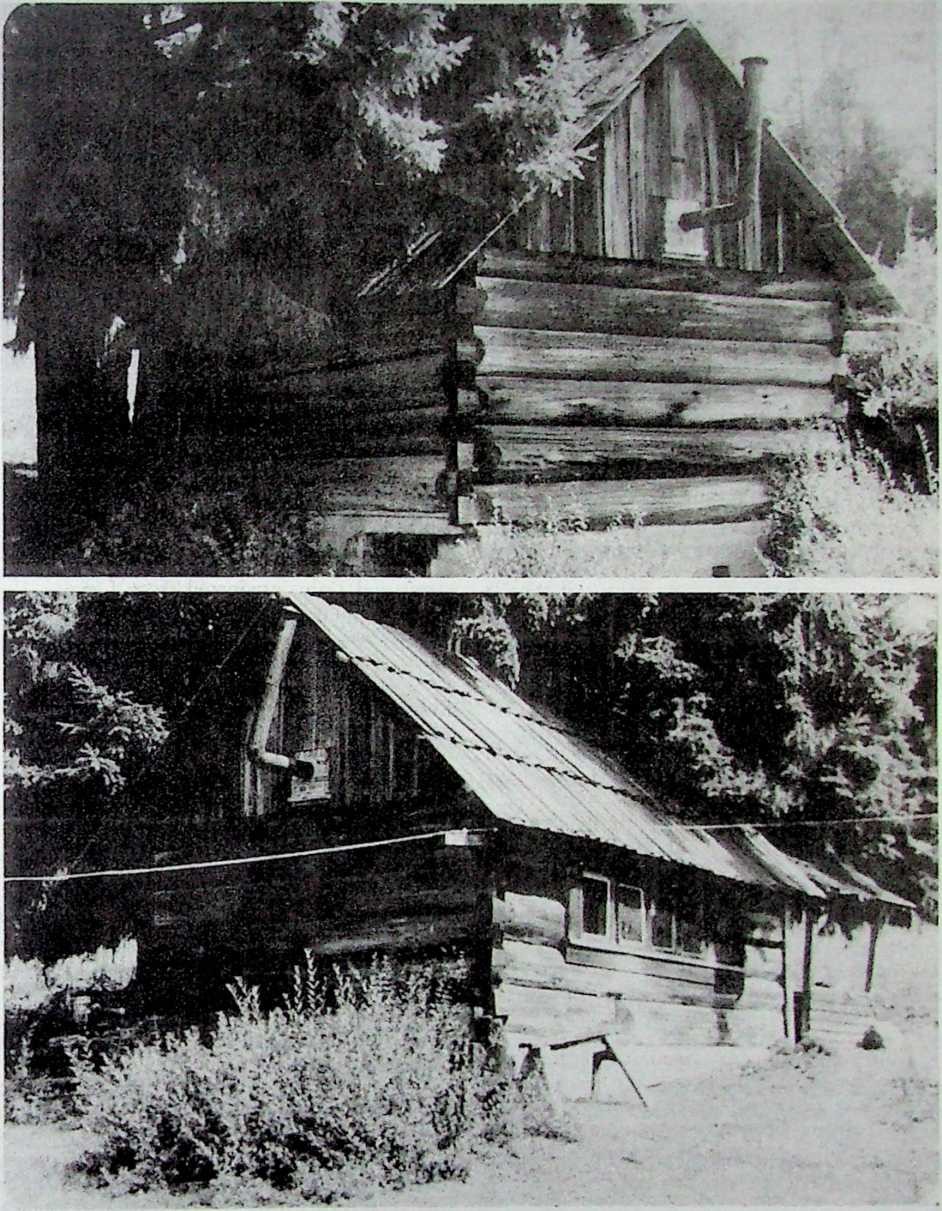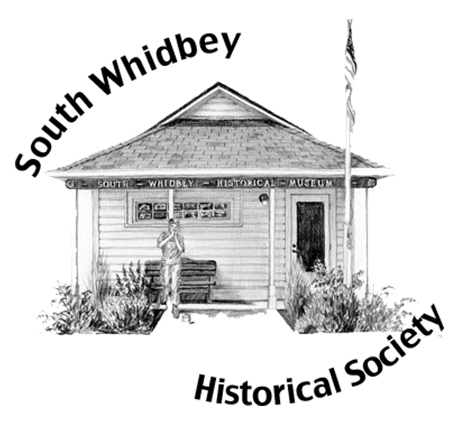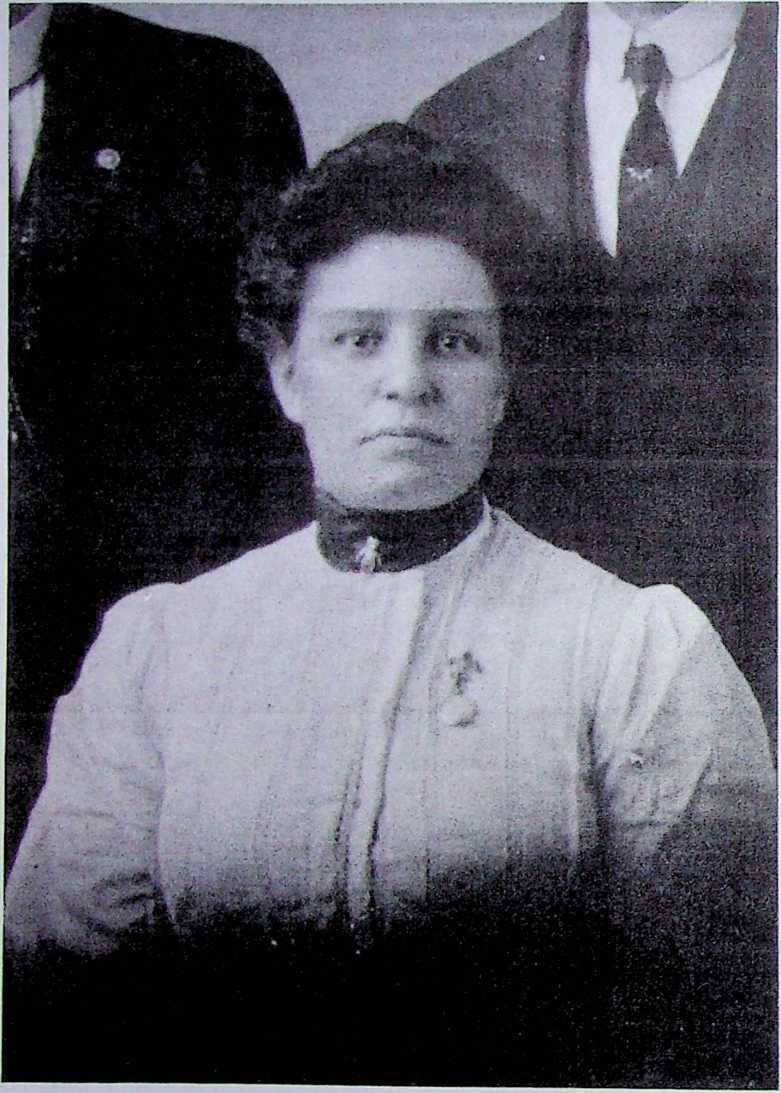The Puget mill was indirectly the reason that Amanda Little Pearson was standing in the yard of her home on top of the hill overlooking Holmes Harbor on a day in 1917, trying to decide whether to laugh, cry, or administer a switch to the seat of her offspring. She had just returned from her stint as cook for the loggers at the mill camp, and the sight which greeted her as she entered her yard was unique, to say the least.
A fearsome looking figure in a black cape, black hat, beetling black eyebrows, and a black handlebar moustache, was clutching a screaming and struggling girl draped in a white lace curtain, while a dashing lad in boots, peg-top pants and open throated shirt was pummeling the figure in black. On the sidelines assorted youngsters were hissing the villain and encouraging the hero.
Amanda smiled. This sort of thing was not unusual. Play acting was a favorite diversion of her children, Otis, Ivan, Bernice, Coral, and Iola and they were usually accompanied in their endeavors by the neighboring Tollefsen youngsters. Suddenly Amanda’s smile turned to a frown. The sickening odor of burning hair assailed her nostrils and it was coming through the open kitchen door. Hasty investigation revealed strands of coarse black hair that looked suspiciously like the end of a cow’s tail boiling in her best pan on the stove, but the pan had boiled dry and the hair was now scorching, and sticking to the utensil.
When she accosted the thespians demanding a reason for the debacle, they regarded her with injured innocence. Their script required that Dashing Don rescue Damsel-in-Distress from villainous Horrendous Harry, but whoever heard of a villain without a moustache? Besides, Old Bessie wasn’t hurt by just clipping off the loose hair at the end of her tail and they had boiled it to kill any germs because “Mother, haven’t you always taught us to be sanitary?”
This is just one of the many interesting accounts of what life was like in the family of Charles and Amanda Little Pearson in the early 1900s as recollected by their grown children, and told to Margaret Little when she interviewed them in 1981.
Long before the arrival of the Socialist colony and most of the other residents of Freeland, Johan Emil Pearson, and his wife, Maria had settled with their children, Andrew, Esther, and Charles, in the Holmes Harbor area and built a log house in 1888 atop the hill overlooking the Harbor on the west and Lone Lake on the east. By the early 1900s, when the Pearsons were well established and their children grown, there arrived on the Harbor a young man, George Little, who was a railroad fireman and had come to work on the donkey engine for the Puget Mill.
He had been working on the railroad run between Spokane and Leavenworth and had been living in the mountain town of Skykomish with his wife, Amanda, and their children Otis, Ivan, and Bernice. The Littles settled in the house at June Beach next to the Puget Mill logging camp and Amanda became camp cook.

This original log cabin was built without nails in 1888 by John Pearson and sons Andrew and Charles on a hill overlooking Holmes Harbor and Lone Lake. The photos above were taken in 1983 by Euna McKinley, grand-daughter of John Pearson.
In 1908 a son, Coral, was bom and daughter, Bernice, tells this story of the occasion.
“Dr. Craig of Langley was my mother’s doctor when Coral was born. He was a large baby, weighing nine pounds. I was five years old at the time and I asked Mother where my new baby brother came from. She told me that Dr. Craig had brought him in his black doctor’s bag. I had a doll and I tried to fit it into the bag but it wouldn’t go. I puzzled for a long time as to how a nine pound baby could come out of that bag when it was too small for even my doll.”
Shortly after Coral’s birth, his father died and Amanda was left to be the bread-winner for her brood. She continued to work at the mill and purchased 20 acres of land just north of their logging camp. She sold the timber on the land to the mill.
The Littles had become friends with the Pearson family and, in the course of events, romance developed between Charles Pearson and Amanda Little. They were married and moved into the spacious log home the Pearsons had built on the brow of the hill. By that time Johan Pearson had died. His son Andrew moved to British Columbia, and his daughter Esther married Elias Kristwick in 1904. She moved to Seattle. Grandma Pearson lived with Charles and Amanda until her death. In 1915, a daughter Iola was added to the Pearson family.
The Pearson home was a lively one, filled with fun and laughter as well as with hard work. Amanda could play both the piano and an old- fashioned pump organ. When she played, the family would gather around her and sing. There was always work to be done as most of the family’s food was home grown such as potatoes, beans, berries, and vegetables. The livestock required attention but work was often interspersed with entertainment. Coral and Ivan summed it up as follows:
“We swam in the summer and played on big log booms in the water. In the winter we had sleigh rides and ice skating. My father and mother always made holidays exciting. We had Easter egg hunts all around the fence rows and fields. My parents dyed the eggs and Charlie hid them everywhere. We hunted for hours.
“We had a big dog, a Saint Bernard named Shep, who hauled us around in a wagon. Sometimes we would hitch him up with the harness and shaft and he would pull us where ever we wanted to go. We also rode him ‘horse back.’
“One time we tried to make our own airplane, out of a box, a broom, and a propeller made from cedar blades. Ivan and Bernice got up in the tree and were going to fly it out. If it didn’t work, Coral was to catch them. It didn’t work but Coral couldn’t catch them. Well, they landed without breaking anything but they suffered a few bruises.
“In the early twenties we grew about four acres of strawberries at Holmes Harbor. A buyer came by boat to pick them up every other day dur¬ing picking season. The time came when the ber¬ries were so cheap that it was not worth raising them. Once Mother had some berries that fer¬mented so she threw them out. The family’s pet goose came and ate them and they did him in. Mother thought he was dead so she wanted to at least save the down. She started to pluck him and was getting right along with the job when he reviv¬ed. The goose survived and so did Mother.
“Father used a boat he built himself. It was a skiff made from hand hewn cedar planking about eighteen feet long. He either sailed or rowed it from the harbor, around the south end of the is¬land, past Possession Point, and then north across to Port Townsend. He also went to a small place near Everett called Gardiner. Sometimes he would be gone for a few days according to the weather. He brought back staples such as sugar, flour, and spices, the things that we did not raise at home.
“Our home was a log cabin. It was built by Charles Pearson and his father. It was a large home with four bedrooms, a family room, and parlor. It was built without nails; the logs were dove-tailed.”
Coral recalled an occasion when he and Ivan were involved in a most unusual situation.
“There was a snow storm that stopped everything on the island. In the winter of 1923, Ivan and
I were returning home from the main-land for Christmas and it was very cold. When we left Mukilteo, the boat was breaking ice that was beginning to form. The rivers had overflowed and fresh water was flooding Saratoga Passage from Mukilteo to Clinton. The water was freezing and forming solid chunks that were sticking together. It is hard to believe, but the boat was ramming ice from the time we left the dock. The captain managed to get within about two hundred yards from the Clinton side before the boat was frozen solid in ice. We left our cars on the boat and ‘walked on the water’ to get ashore. The boat didn’t get to shore until the following day. I don’t believe that has ever happened again.”
Both Coral and Ivan recalled that transportation in Freeland’s earlier days posed quite a problem. “Most people took a boat to Everett or Seattle for anything other than groceries. Langley had a barber shop, hardware store, blacksmith shop, and hotel. Transportation was so slow that hotels were necessary.”
Coral recalled the part he and Ivan and their step-father, Charles Pearson had in building roads in the area.
“Travel was by horse, horse and buggy, or on foot. We had a road cut through the trees to get to Bayview and Langley. In later years, Charles Pearson and I built the original road from our property overlooking Lone Lake to my mother’s property on Holmes Harbor where we moved when I was (1919). We built the road by using scrapers pulled by horse, and we blasted stumps with dynamite. The road started about a mile north of Freeland to just past the present Goss Lake Road. It is now called East Harbor Road. Later, the county completed the road as far north as the Brainard property to where Ivan Little now lives (in 1981).
My brother Ivan, myself, and Charles Pearson also cut through the Goss Lake Road, essentially the same route as it is today (approximately 1920). We were paid $3 a day by the county then, which seemed like good pay at the time.”
Ivan and Coral’s sister Bernice Little Kleparek, who was bom May 30, 1903, was three years old when her parents moved to Freeland. She has several recollections of her own that supplement those of her brothers.
“Mother had a spinning house on the Holmes Harbor property. She purchased the warp from Sears and Roebuck Company to weave rugs (1912-1917). She had a spinning wheel and a weaving loom. One time she strung the warp out of doors. A wind came up and blew it everywhere, in the trees and bushes. The warp was strung length-wise, and she used a shuttle for the crosswise threads. In later years I wove rugs on the same loom. (Bernice’s daughter Betty still has the loom and is weaving on it in 1985.)
“Mother shopped in a store located at the foot of Woodard Avenue. It was owned by the Spencers. Then there was the Prather’s store, too. One time mother left us home to go shopping. We heard a noise and thought it was a ghost. We all ran to town to find Mother. We found out when we got home that she had left the dog in the house and he was the ghost.
“The summer that we lived in the camp house on Holmes Harbor, I played in the water so much that Mother was afraid I would have barnacles. My step-father’s mother died that summer (Grandmother Maria Pearson). He worked for the Strawbridges on Saratoga Road near Langley.
“In the summer time my mother made pies, cakes, and cooked for the logging company on Holmes Harbor. We used to sit on the camp house steps and watch. The camp house was located where the support timbers stand, just north of the property that Mother purchased on Holmes Harbor. (Twenty acres is still lived on by her immediate family.) We moved to a house in the ravine, which was owned by people called Hag- gens. There was a sluice box there. The water came down the ravine like a waterfall. (It is still there.)”
Both Bernice and Coral had vivid recollections of the Indians around their home when they were children. Coral said, “There were some. My mother and father traded with them. They traded potatoes for salmon. Two of the Indians that came through the marsh to our place were called Tom and Susie. When I saw the Indians coming, I used to run and hide in the barn under a cow. They came from across Holmes Harbor north of the present golf club. They processed fish. There was an Indian burial site on what we called the second spit, now known as Beverly Beach. We were forbidden to go there.”
Bernice added her recollection of the Indians. “My mother wanted me to wear a bonnet because I was so fair. I loved to climb up on the fence to watch for the Indians. She was very much afraid of them and when I wouldn’t wear my bonnet, she used to threaten to sell me to the Indians.”
Charles Pearson died shortly after his 81st birthday in 1953. Amanda preceded him in death May 6, 1942, after suffering a serious illness. Otis Little died prior to 1960. His family’s summer home is on Amanda’s original property.
Ivan and his wife Mary, who worked in the Langley post office for several years, have remained on the island and are living in their original home on Holmes Harbor in 1985. They have four children. Their daughter, Martha Little French, lives on the harbor next to June Beach. Both son Aaron and Dann graduated from Langley High School. Coral’s daughter, Lois Foster lives on East Harbor Road next to Ivan and she and her cousin, Martha French work at Coupeville Hospital.
Coral Little, who was a member of the South Whidbey Historical Society Board and co-curator of the museum with his wife, Margaret, died in the spring of 1984.
Andrew Pearson worked as bookkeeper and other occupations with the logging camps around the harbor, later moving to British Columbia, and finally, to Everett where he lived with his sister Esther until his death in 1948.
Esther Pearson lived at the family home until her marriage to Elias Kristwick in 1904, when she and her husband moved to Seattle where their daughter, Ethel was born. A few years later they returned to the area where they built a home overlooking Holmes Harbor on what is now Eaton Road. Their daughter Martha was born in this house in 1907.
For a time Elias Kristwick operated the Alvarene passenger and freight boat owned by J. H. Prather. In 1908, the Kristwicks moved to Everett where their daughter Helen was born in 1909. Another daughter Euna was born in 1912. In 1944 Euna and her husband William McKinley purchased a summer home at Beverly Beach on the harbor and retired to the island permanently in 1970. Andrew died in 1948 and Esther in 1960. Both are buried in the Bayview Cemetery. Ethel died in 1914 and is also buried in Bayview Cemetery.

